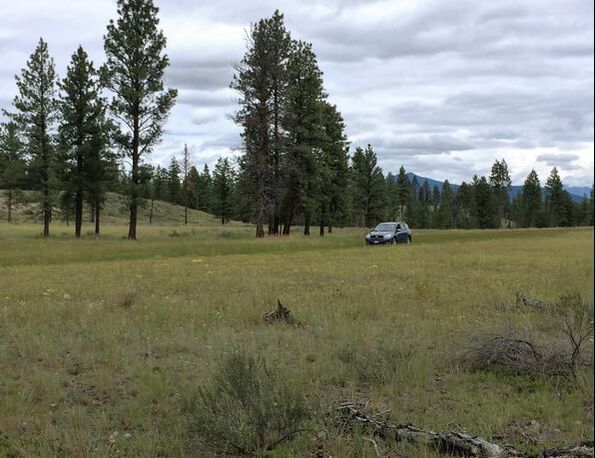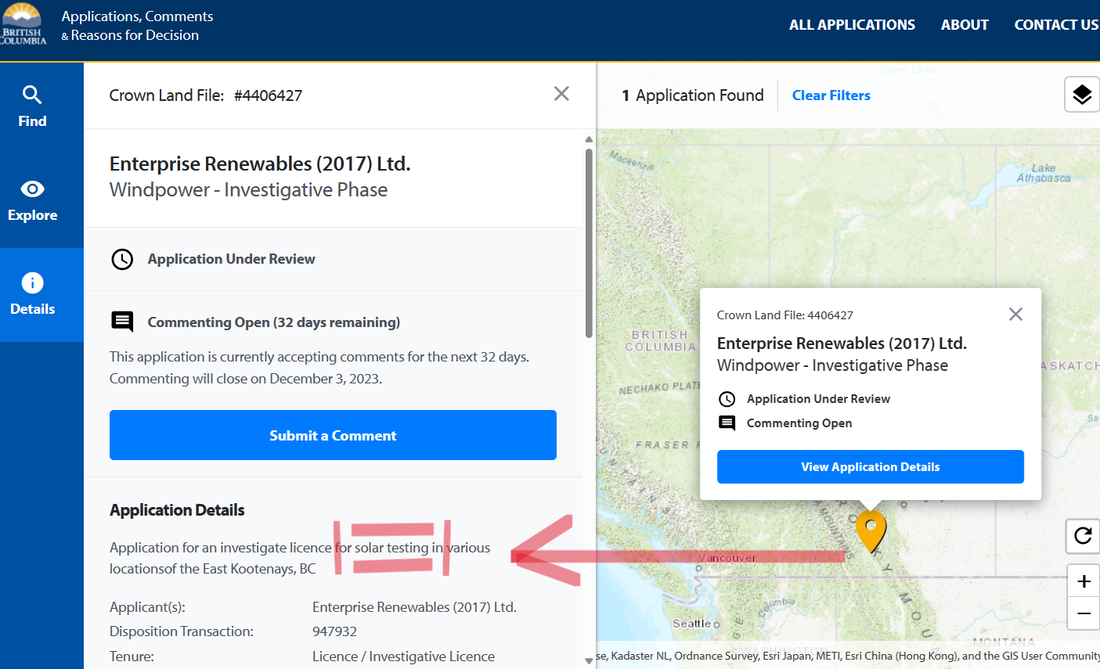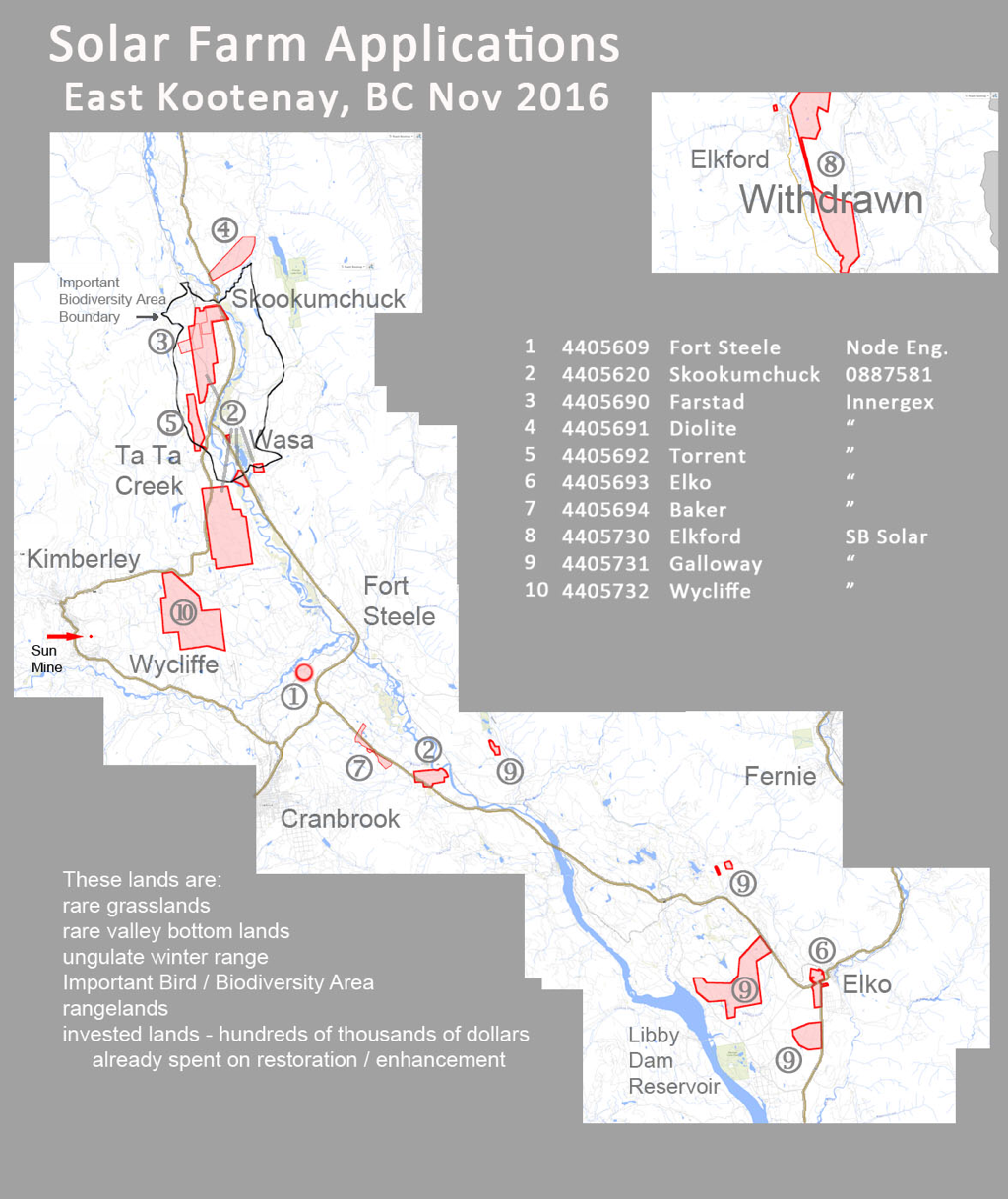 Restored grassland and open pine forest on Skookumchuck Prairie, critically endangered habitat and home of threatened Lewis' Woodpecker and Long-billed Curlew and more.
Restored grassland and open pine forest on Skookumchuck Prairie, critically endangered habitat and home of threatened Lewis' Woodpecker and Long-billed Curlew and more. BC Government - Applications, Comments & Reasons for Decision
Comment by December 3, 2023
https://comment.nrs.gov.bc.ca/applications?clidDtid=4406427&id=6529b28b646c73002270b4ab#details
The Issue:
Environmentally valuable and irreplaceable rangeland and grassland in the East Kootenay Trench is once again under threat from major development.
A company wants to develop utility-scale solar power plants on ecologically productive grassland and rangeland home to the threatened Long-billed Curlew, Lewis’ Woodpecker, the endangered Williamson’s Sapsucker, and American Badger.
Almost 5,000 hectares throughout the Kootenay River valley are being sought. That’s the same area as over half of what will be flooded by the Site C dam. The East Kootenay has already lost significant tracts of land to dam building.
For now, the developer wants only to measure the amount of sunlight, termed solar irradiance, to see if there is enough for industrial-scale solar farms. But this information is already available and can be measured from satellites so there is no real need.
Similar tenures, requested in 2016, were rejected by the Province of BC and not supported by the Regional District of East Kootenay after many groups and individuals submitted comments. The reasons the Government gave for not allowing the tenures included the following:
“The area selected is within an endangered grassland ecosystem which is being actively managed and restored. This ecosystem provides critical habitat for ungulates (primarily elk) and species at risk and is an important cattle grazing area”
“…any future solar energy facility would be incompatible with protecting the grassland due to the need to fence off the facility”
“This project poses an unacceptable risk to an already endangered ecosystem”
The Problem:
Solar power is seen as one of the cleanest ways to produce energy. Developing it can help us manage our climate crisis and that’s a good thing – we must do it. But we have roof tops, gravel pits, old mine sites, and waste fields that can be used for solar farms; using grassland and rangeland is not necessary.
What’s wrong with a few panels out in a field? Well, this wouldn’t be a few panels, it would be hundreds of them covering many hectares. They would shade the native grassland plants, adapted to full sunlight, and they would die.
Preventing invasive plants from taking over under the panels would require great care and maybe lots of chemicals. Sulphur cinquefoil, knapweed, and cheatgrass are already a major problem on our native grasslands.
The solar farms would need to be fenced off for security and fire protection. This means:
- Loss of winter ungulate range for the elk and deer
- Loss of high-value rangeland from local cattle ranches
- Loss of habitat for species at risk that are dependent on grassland and open pine forest
- Severe costs to protecting those facilities from wildfires and prescribed burning done for ecological restoration
These are just some of the impacts.
The Province of BC still does not have any policies or guidelines for large-scale solar farm developments.
The loss of temperate grassland continues. In 2021, almost 650 thousand hectares (1.6 million acres) were converted to row crops in the US and Canada, according to the World Wildlife Fund (Plow Report 2023).
Fortunately, we have managed to protect some of the little bits of grassland and rangeland we have left here, so far, and ecological restoration work continues.
Why are grasslands so important?
The World Wildlife Fund (WWF) expresses this very well; they say:
“Grasslands are essential to people, nature and climate. They hold approximately one-third of global terrestrial carbon stocks and provide critical resilience in the face of climate change, including drought, heat and wildfire.”
They hold carbon, filter water, provide breaks between forest stands, grow things where trees can’t grow, help increase biodiversity, provide natural food for deer and elk, to name a few benefits.
The International Union for Conservation of Nature and Natural Resources describes temperate grasslands as the world’s most endangered ecosystem – more endangered that tropical reefs or the Amazon Rainforest.
The WWF says that more than 70% of America’s prairies have been destroyed.
The North American Bird Conservation Initiative, in their "State of Canada's Birds, 2019, reports that grassland birds have declined by 87% and 300 million birds have disappeared since 1970, or 2 out of every 3 birds.
Skookumchuck Prairie KBA
The fields between Lantz’s farm and Skookumchuck don’t really look like much to us, especially at this time of year – all just a pale, wind-swept yellow grey.
But from early spring to autumn, its a busy place. Native bees and other pollinators, feral domestic bees, untold numbers and species of butterflies and insects, the usual chipmunks and squirrels, and thousands of birds from a dozen different species all buzzing and singing and mating and incubating and raising their young, frantically trying to get the job done before the snow flies again.
Most bird species in the grassland are the colour of last year’s dried grass still sticking up between the new green stems. You don’t see them much, because they don’t want to be seen – it’s safer that way for them; but you can sure hear them (at the right time of year).
Dozens of Western Meadowlark and Vesper Sparrow males singing their little hearts out filling the air with their bubbly little songs and flitting between this place and that, catching bugs.
And one of the weirdest birds you might spot is the Long-billed Curlew (Threatened, SARA) (Threatened, Blue, BC), presiding quietly over all the activity.
Yes, they are cousins with the other shorebird species you might be familiar with, like Killdeer, or Avocets; and they do look like just a big sandpiper – but with a very long bill and they're a shorebird ... in the grass ... no beaches or shores in sight.
In the winter, and in the summer between incubating or guarding their chicks, they DO hang-out on the shore, and riverbanks, mud flats, and agriculture fields.
In the winter, the birds from Skookumchuck Prairie fly down to central and southern California – which we know from having put solar-powered satellite transmitters on a half dozen of them and following their movements. Very cool.
And over against the hillside, where millions of dollars worth of ecosystem restoration work has taken place over the past 35 years, dozens of rosy-breasted woodpeckers make their summer homes.
This is likely Canada’s densest breeding population of Lewis’ Woodpecker (Threatened, SARA) (Threatened, Blue, BC). I have found dozens of nests and identified almost four dozen nesting trees on the edge of the Prairie over the past 9 years. They have benefited greatly from the restoration work done here.
There are American Kestrels – our smallest falcon, also nesting in cavities in old trees, sometimes in the same tree as a Lewis’; and Common Nighthawks (Threatened, COSEWIC) (Secure, BC) nesting on the ground, their two little speckled eggs in just a shallow hollow where the parents may have bothered to move a pebble or bark chip out of the way. And Mountain Bluebirds, and dozens of other species of birds. It’s a busy place.
Inches deep, all over the fields, there are elk droppings, evidence of their substantial use of the area on long winter nights. This is what natural diversity looks and sounds like.
Skookumchuck Prairie Key Biodiversity Area (KBA) is recognized internationally as critical to restoring the biodiversity and health of the global ecosystem. It is one of the few pockets of grassland not privately owned. The KBA programme was developed by Bird Life International and is administered by BC Nature in British Columbia. Some countries have incorporated these areas into their conservation protection laws. Unfortunately, Canada is not one of them, yet.
Summary
In the developer’s application for crown land, they claim this land “has previously been disrupted by forest activities or consists of low-lying scrubland” but that is not true. It’s not scrubland – it’s grassland, rangeland, and winter ungulate range. It wasn’t disrupted by forest activities – it was healed so that many of our grassland-dependent species once again have homes and feeding areas.
There are so many other places better suited to solar panels:
- reclaimed mine and industrial sites
- roof tops on malls, garages, houses
- over parking lots
- on waste-water reservoirs, and so on
- places we’ve already altered which can’t be reclaimed
So, if covering over critical and ecologically sensitive rangeland and grassland with solar panels doesn’t make much sense to you either, please be sure to make your thoughts known. Comment on this tenure application and urge the government to implement clear guidelines so renewable energy companies can pursue projects that are ecologically profitable, too.
Please search for or go to the following link by December 3, 2023 to submit a comment and/or write to your government representatives:
British Columbia Applications Comments & Reasons for Decisions
Crown land application file number #4406427 at:
https://comment.nrs.gov.bc.ca/applications?clidDtid=4406427&id=6529b28b646c73002270b4ab#details
If you read down under "Application Details" you will see they say "solar testing in various locations"
Also NOTE the pin on the map is not in the right place. That is because they are asking for parcels stretching from Elko to Skookumchuck so the pin gets put in the middle.
You can scroll down on the left panel and open copies of the application and the map. And if you scroll down a little further you will see a map with all the parcels
List of representatives responsible:
Federal, Provincial, and Regional Government Contacts:
Honourable Josie Osborne, Minister of Energy, Mines and Low Carbon Innovation
[email protected]
Honourable George Heyman, Minister of Environment and Climate Change Strategy
[email protected]
Honourable Bruce Ralston, Minister of Forests
[email protected]
Honourable Nathan Cullen, Minister of Water, Land and Resource Stewardship
[email protected]
Doug Clovechock, Columbia River Revelstoke
[email protected]
Tom Shypitka, Kootenay East
[email protected]
Rob Morrison MP Kootenay-Columbia
[email protected]
Sonia Furstenau, MLA Cowichan Valley
[email protected]
Rep Jane Walter, Electoral Area E, RDEK
[email protected]
Rep Rob Gay, Electoral Area C, RDEK
[email protected]
Rep Stan Doehle, Electoral Area B, RDEK
[email protected]
Summary of reasons to reject / disallow this crown land tenure application:
We strongly support the development of solar power as a renewable energy source to off-set the effects of climate change and global warming. But rather than large-scale utilities, we believe a decentralized approach with small-scale installments would better fit our priorities of maintaining natural areas and increasing biodiversity.
Parcels requested in this tenure application were previously disallowed.
Parcels requested in this tenure application are:
- within an endangered grassland ecosystem which is being actively managed and restored. These areas provide critical habitat for ungulates and species at risk and are important for cattle grazing.
- internationally recognized as a Key Biodiversity Area, critical for maintaining or increasing global biodiversity as defined by Bird Life International.
Reasons for concern and protection of these parcels:
- The need for fencing of any future utility-scale solar infrastructure would remove critical habitat, fragment the grassland ecosystem further, and increase challenges for wildfire control, habitat restoration, and invasive plant species management.
- Utility-scale solar plants are an industrial use incompatible with our objectives for managing our agricultural rangelands and natural ecosystems.
- Temperate grassland, of which parcels of this tenure are comprised, is the world’s most endangered ecosystem according to The International Union for Conservation of Nature and Natural Resources.
- Parcels requested in this tenure application contain Canada’s densest breeding population of the threatened Lewis’ Woodpecker, and impacts would be difficult to impossible to mitigate.
We urge the BC Government to develop and implement policies, guidelines, and procedures for the responsible de-centralized development of solar power in British Columbia so that
- the challenges of climate change and global warming are not exacerbated by the removal of naturally functioning and critical ecosystems
- so that developers can have greater confidence in planning and implementing their projects
- so that energy users can be confident they are minimizing their global warming emissions without avoidable increase in harm to the global ecosystem


 RSS Feed
RSS Feed
